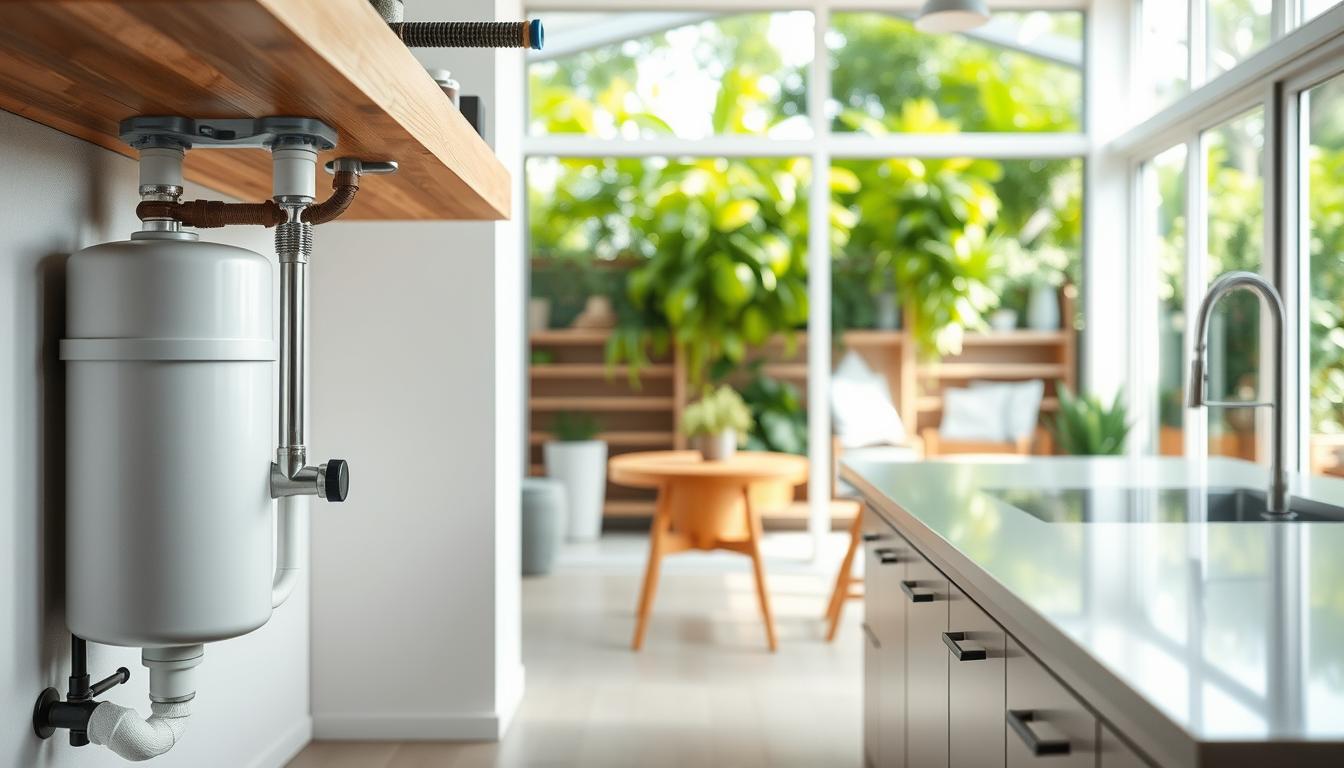Water is getting more precious in many parts of the United States. Droughts are more common, and water bills keep going up. Homeowners are looking for ways to use less water without giving up comfort.
Greywater recycling is a smart solution. It lets you use water from sinks, showers, and washing machines for other things in your home. This simple method can cut your water use by 30-50% and make your home more eco-friendly.
Greywater systems are flexible and easy to use. You can start with a simple DIY setup for just a few dollars. Or, you can get a more advanced system that fits right into your plumbing. There’s a solution for everyone, no matter your budget or skill level.
In this guide, we’ll show you how to set up greywater systems in your home. We’ll also talk about the rules you need to follow and how to join others who care about water. Are you ready to change how you use water, save money, and help the planet?
The Growing Water Crisis and Why Conservation Matters
The United States is facing a water crisis that affects our environment and daily life. Despite having modern conveniences, many people don’t realize how rare freshwater is. Climate change, growing populations, and wasteful water use are making our water supplies very tight.
Water conservation is not just a trend; it’s essential for survival. The average American uses about 82 gallons of water daily at home. This is way more than what’s sustainable, while many areas face severe droughts and dwindling groundwater.
Freshwater is less than 3% of Earth’s water, and only a small part is safe for us to use. As this resource gets scarcer, communities face water limits, higher bills, and environmental harm.
But there’s hope. Households can make a big difference. By using water-saving strategies like greywater recycling, we can save this vital resource. We also cut down on our environmental impact and save money.
Current Water Scarcity Statistics in the United States
The water crisis in America is real and happening now. About 40% of the U.S. faces drought every year. The Southwest and Western states are hit the hardest, with some areas in drought for over a decade.
California, Arizona, and Nevada are facing severe challenges. Major reservoirs like Lake Mead are at historic lows. Even the mighty Colorado River, which supplies seven states, has seen its flow drop by nearly 20% in a century.
The Ogallala Aquifer, vital for eight Great Plains states, is being drained fast—up to 2 feet a year in some spots. At current rates, parts of this crucial source could be drained in 25 years.
| Region | Water Stress Level | Major Challenges | Projected Years Until Severe Shortage |
|---|---|---|---|
| Southwest | Extreme | Prolonged drought, population growth | 5-10 |
| California | High | Agricultural demands, reduced snowpack | 10-15 |
| Great Plains | Moderate to High | Aquifer depletion, irrigation needs | 15-25 |
| Southeast | Moderate | Urban growth, saltwater intrusion | 20-30 |
| Northeast | Low to Moderate | Aging infrastructure, seasonal drought | 30-40 |
The Environmental Impact of Excessive Water Consumption
Our water use affects more than just our bills—it harms the planet. Using too much water depletes resources and disrupts ecosystems. Rivers, lakes, and wetlands suffer when water is diverted for us, leading to habitat loss for many species.
Water treatment and transport are energy-intensive. In California, water-related energy use is nearly 20% of the state’s electricity. Saving water reduces our carbon footprint and supports environmental sustainability.
Excessive water extraction causes land to sink. This has been seen in many U.S. areas, damaging buildings and reducing aquifer capacity.
Water pollution worsens these issues. More water use means more wastewater, which can contain harmful substances. These pollutants harm aquatic life and may affect human health.
By conserving water, like through greywater recycling, we can protect our watersheds. Every gallon saved helps ensure a sustainable water future for all.
What Is Greywater Recycling and Why Should You Care?
Greywater recycling is a way to save water in your home. It captures water from activities like showering and laundry. This water is then reused instead of being wasted.
Every day, a typical household throws away 30-50 gallons of water. This water can be used again for things like watering plants or flushing toilets.
There are many types of greywater systems. They can be simple or complex. These systems collect water before it goes down the drain and use it for other purposes.
For those who care about the environment, greywater recycling is a great choice. It helps save water without making your life less comfortable. It’s a step towards living more sustainably.
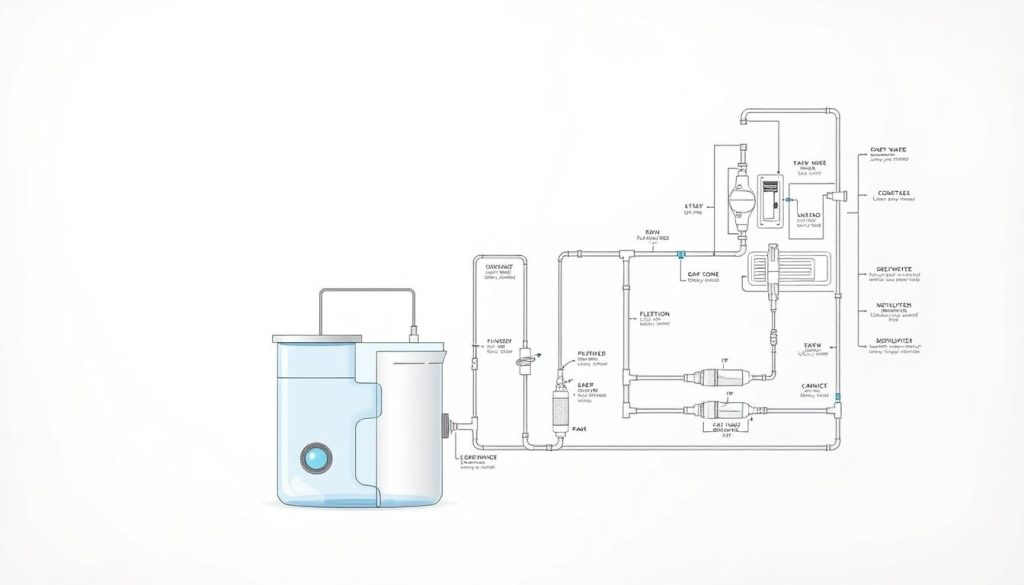
Defining Greywater Sources in Your Home
Greywater comes from different places in your home. Bathroom sinks and showers are big sources. They produce water that’s mostly clean.
Washing machines also generate a lot of greywater. This can be up to 40 gallons per load. Kitchen sink water can also be used, depending on where you live.
Knowing where greywater comes from helps you plan better. You can design a system that saves the most water.
The Difference Between Greywater and Blackwater
Greywater and blackwater are different. Greywater is mostly clean and safe for reuse. It comes from sinks and showers.
Blackwater, on the other hand, is dirty. It comes from toilets and kitchen disposals. This water needs special treatment before it can be reused.
This difference is why greywater can be used in gardens. But blackwater must go to treatment plants or septic systems. Knowing this keeps your water recycling safe and effective.
The Circular Water Economy at Home
Greywater recycling creates a water cycle in your home. Water is used over and over again. This is different from the usual way water is used and wasted.
For example, shower water can water your garden. This garden can grow food for you. Washing machine water can water plants that add value to your home.
This way of using water is like nature. It makes the most of every gallon. By doing this, you’re not just saving water. You’re changing how you view water.
The Environmental Benefits of Implementing Greywater Systems
Greywater recycling systems are a big step towards sustainable living. They help solve water scarcity by reusing water. This makes your water cycle more sustainable at home.
Reducing Freshwater Consumption
Greywater systems cut down on freshwater use. They use water for secondary needs instead of wasting it. Homes with these systems use 30-50% less municipal water each year.
A family of four can save 40,000 gallons of water yearly. This is by using shower and laundry water for irrigation. It helps keep local water sources fresh and supports sustainability in water-stressed areas.
Decreasing Wastewater Production
Recycling greywater means less water for treatment plants. This lowers the load on old infrastructure. It also cuts down on energy and chemicals needed for treatment.
Studies suggest greywater systems could cut wastewater volume by 40%. This saves money for treatment plants and reduces environmental harm. It makes plumbing more sustainable.
Lowering Your Household’s Carbon Footprint
Water management uses a lot of energy. Municipal systems and homes both use electricity for water. Greywater recycling changes this.
Greywater systems cut down on energy use by 20-30%. This lowers greenhouse gas emissions. It’s a big step towards reducing your home’s carbon footprint.
Using greywater for irrigation also helps plants grow better. This improves carbon sequestration. Together, these actions greatly reduce your home’s environmental impact. They promote water conservation for the planet.
Economic Advantages: How Greywater Recycling Saves Money
Greywater recycling is not just good for the planet. It also makes financial sense for your home. Many people start thinking about it for the environment, but the money savings are a big plus. Knowing how it can save you money helps make the initial cost worth it.
Reducing Monthly Water Bills
Greywater recycling cuts down on water use right away. The average home uses 300 gallons of water daily, with 50-80% being greywater. By using this water again, families can use 30-50% less fresh water.
In places where water costs keep going up, you’ll see your bills drop fast. In dry areas like California or Arizona, you might save $30-$60 a month. Even simple systems can save up to 15 gallons per load.
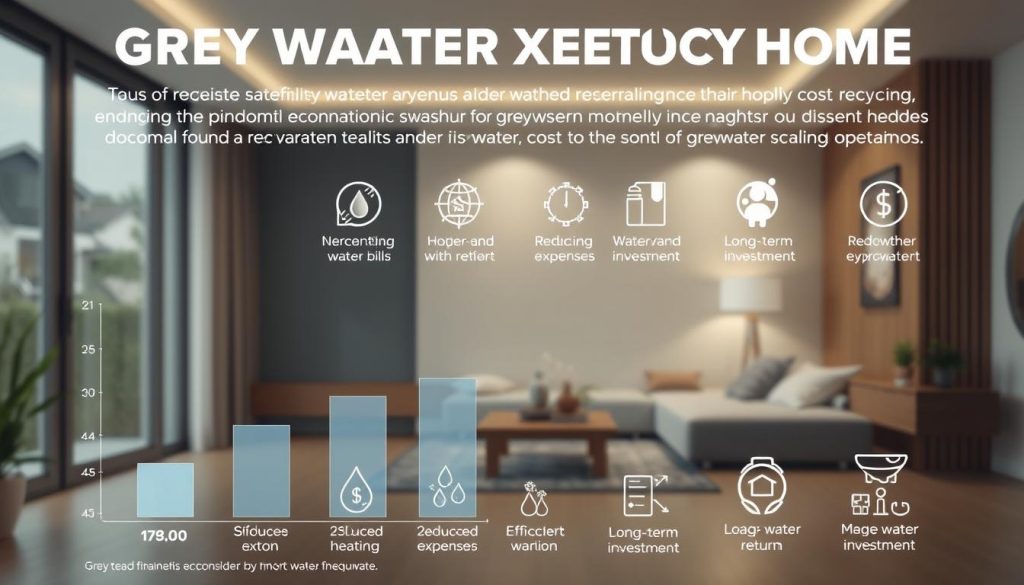
Long-term Financial Benefits
Greywater systems offer more than just lower bills. They can also make your septic system last longer, saving you thousands. With less water, you won’t need to pump it as often, saving money on maintenance.
Using greywater for your garden can also save you money. Your plants will be healthier and need less fertilizer. Plus, homes with greywater systems often sell for more because they’re seen as eco-friendly.
Available Tax Incentives and Rebates in the US
Many places offer money back for installing greywater systems. This can include rebates on parts or even lower property taxes. In California, you can get up to $1,000 back from water districts.
In Arizona, you might get a 25% tax credit on costs. Texas and New Mexico offer property tax breaks for water-saving upgrades. Local utilities often add to these offers, making it even more appealing.
| Region | Average Monthly Savings | Typical Payback Period | Available Incentives |
|---|---|---|---|
| Southwest US | $45-65 | 2-3 years | Tax credits, rebates up to $1,500 |
| West Coast | $35-55 | 3-4 years | Utility rebates, permit fee waivers |
| Northeast | $25-40 | 4-5 years | Property tax reductions, grants |
| Southeast | $20-35 | 4-6 years | Limited municipal programs |
Simple DIY Greywater Systems for Beginners
Turning your home’s greywater into a useful resource is easy. These DIY systems are great for those who want to save water and help their plants. You can find the tools and materials you need at most hardware stores.
Laundry-to-Landscape Systems
Laundry-to-landscape systems are a great place to start. They use washing machine water for your garden without changing your plumbing.
Materials Needed
- 1-inch PVC pipe and fittings
- 3-way diverter valve
- Mulch basins (for distribution points)
- Irrigation tubing (1-inch diameter)
- Hose clamps and zip ties
- PVC primer and cement
Step-by-Step Installation
- Disconnect your washing machine drain hose from the standpipe.
- Install the 3-way diverter valve to allow switching between sewer and landscape.
- Connect PVC piping from the valve to exit your home (through a wall or window).
- Create a gentle slope in your piping (1/4 inch per foot) to ensure proper drainage.
- Install distribution points with mulch basins around plants you wish to irrigate.
- Test the system with a load of rinse-only laundry to check flow patterns.
Sink-to-Garden Setups
Bathroom and kitchen sinks also produce greywater for your garden. These systems are a bit more complex but still doable for DIY fans.
To set up a sink-to-garden system, you need a diverter valve under your sink. This valve redirects water before it goes down the drain. The water then goes to your garden through tubing, where it’s spread out by mulch basins or pipes.
For kitchen sinks, add a filter to catch grease and food particles. But, kitchen water with meat or too much grease should still go to the sewer to avoid harming your garden.
Shower Water Diversion Methods
Shower water is a big source of greywater. The simplest way is to use a bucket in your shower to catch warm water. This water can then be carried to your plants.
For a more advanced setup, use a three-way valve to divert shower water to your garden. You’ll need:
- A diverter valve installed at shower drain level
- 1.5-inch PVC piping for water transport
- A surge tank to manage water flow during heavy use
- Mulch basins or distribution points in your garden
Before you start any greywater system, check your local laws. Many places encourage greywater use but have rules about how far it can be from property lines and how deep mulch basins can be.
Advanced Greywater Recycling Technologies for Homes
Home water management has evolved with cutting-edge greywater recycling technologies. These systems are more efficient and automated than DIY setups. They can transform your home’s water flow and reduce environmental impact.
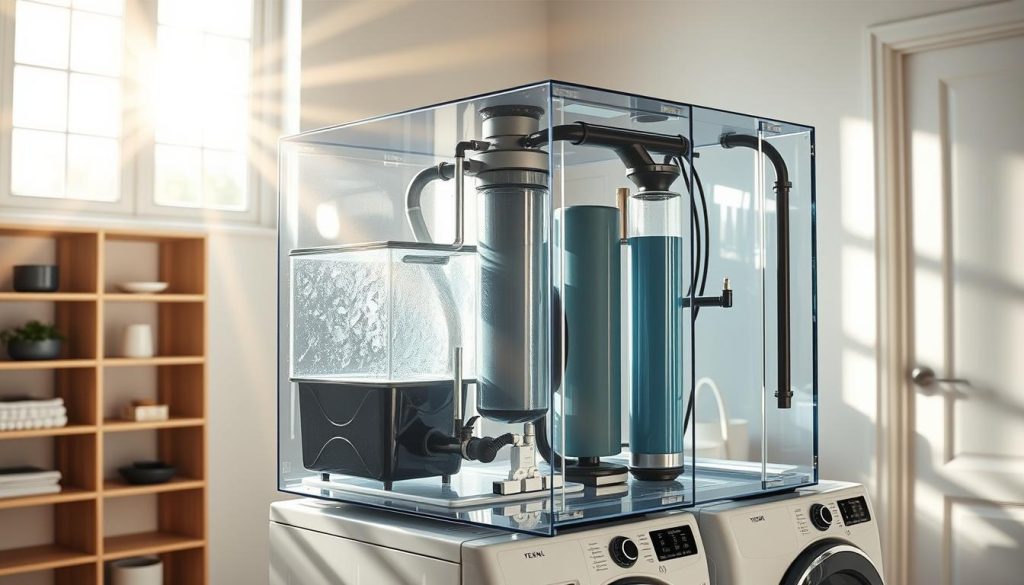
Commercial Filtration Systems
Modern greywater filtration systems use advanced tech to purify water. They come in various sizes and methods, offering cleaner water than DIY setups.
There are several filtration technologies available:
- Sand filtration systems – Cost-effective and easy to maintain, removing larger particles
- Membrane filtration – Cleans water thoroughly, removing tiny contaminants
- Biological treatment systems – Use bacteria to break down organic matter
- UV purification add-ons – Add extra disinfection for better water quality
Systems like the Aqua2use GWDD and Flotender are ready-to-use and installed by pros. Prices range from $1,000 to $5,000, depending on capacity and features. They can handle 100-200 gallons daily with minimal upkeep.
Smart Water Management Solutions
Smart technology has merged with water reuse systems, leading to sustainable plumbing. These systems monitor and control water use in your home.
Smart water management includes:
- Real-time water quality sensors for safety
- Automated controls for directing water
- Smartphone apps for usage data and alerts
- Integration with platforms like Google Home or Amazon Alexa
Systems like the Hydraloop and Phyn Smart Water Assistant detect leaks and analyze water quality. They adjust water distribution based on your needs. These systems save water and offer peace of mind with constant monitoring.
Integrated Home Water Recycling
Integrating multiple water sources and uses in one system is the most effective approach. These systems treat greywater and rainwater, offering a complete water management solution.
Integrated systems are best for new homes or major renovations. Companies like WAHASO and Rainwater Management Solutions provide custom designs. These can cut freshwater use by up to 50%.
The benefits of integrated systems include:
- Year-round water availability from multiple sources
- Custom solutions based on household size and needs
- Centralized management of water conservation efforts
- Greater resilience during droughts or water restrictions
While these systems cost $5,000 to $15,000, they offer significant water savings. They can also increase property value in water-conscious areas.
Safe and Effective Greywater Irrigation Practices
Using greywater for your garden can save water and money. It’s a smart way to reuse water from sinks, showers, and washing machines. But, not all plants like greywater, so it’s important to use it right.
When setting up a greywater system, safety is key. Use soaps that are safe for plants, water below the soil, and choose the right plants for your garden.
Plant Types That Thrive with Greywater
Fruit trees like apples and plums love greywater. They grow strong roots that use the water’s nutrients well.
Ornamental shrubs like lavender and rosemary also do great with greywater. They’re perfect for water-saving homes.
But, don’t use greywater on plants that need acidic soil. Plants like blueberries don’t like the alkaline water. Also, water leafy greens and root veggies with fresh water.
| Plant Category | Greywater Compatibility | Examples | Special Considerations |
|---|---|---|---|
| Fruit Trees | Excellent | Apples, figs, pomegranates | Benefit from nutrients in greywater |
| Ornamental Shrubs | Very Good | Lavender, rosemary, sage | Drought-tolerant varieties do best |
| Perennial Flowers | Good | Sunflowers, yarrow, salvias | Avoid direct contact with blooms |
| Vegetables | Limited | Corn, squash, tomatoes | Use for plants where edible parts don’t touch soil |
| Acid-Loving Plants | Poor | Blueberries, azaleas, ferns | Avoid greywater use entirely |
Irrigation Methods and Best Practices
How you water plants with greywater is important. Subsurface irrigation is best. It keeps the water away from people and plants.
Mulch basins are great for greywater. They filter the water and stop it from pooling. Just dig a basin, fill it with mulch, and direct the greywater there.
Don’t spray greywater on plants. Use gravity-fed systems instead. Keep the system away from property lines and storm drains.
Seasonal Considerations for Greywater Use
Manage your greywater system differently with the seasons. Use a diverter valve to send greywater to sewers when it rains a lot. This stops waterlogging and nutrient overload.
In summer, spread greywater around your garden more. Make a schedule so different areas get water on different days. This stops salt buildup.
In cold weather, winterize your greywater system. Some people send all greywater to sewers, while others use insulated lines. Make sure pipes won’t freeze and burst.
Navigating Greywater Regulations in the United States
Understanding the rules for greywater systems at home can be tough. The benefits are clear, but the laws are often unclear and vary a lot. Knowing the rules before you start can save you a lot of trouble and legal problems later.
As saving water becomes more important, many states are updating their laws. But, the speed of these changes varies a lot across the country. This creates a mix of rules that homeowners need to carefully follow.
State-by-State Regulatory Overview
Greywater rules change a lot from state to state. Western states like Arizona, California, and New Mexico have good, detailed rules for greywater. Arizona has a special system that lets you install simple systems without a permit if they follow basic rules.
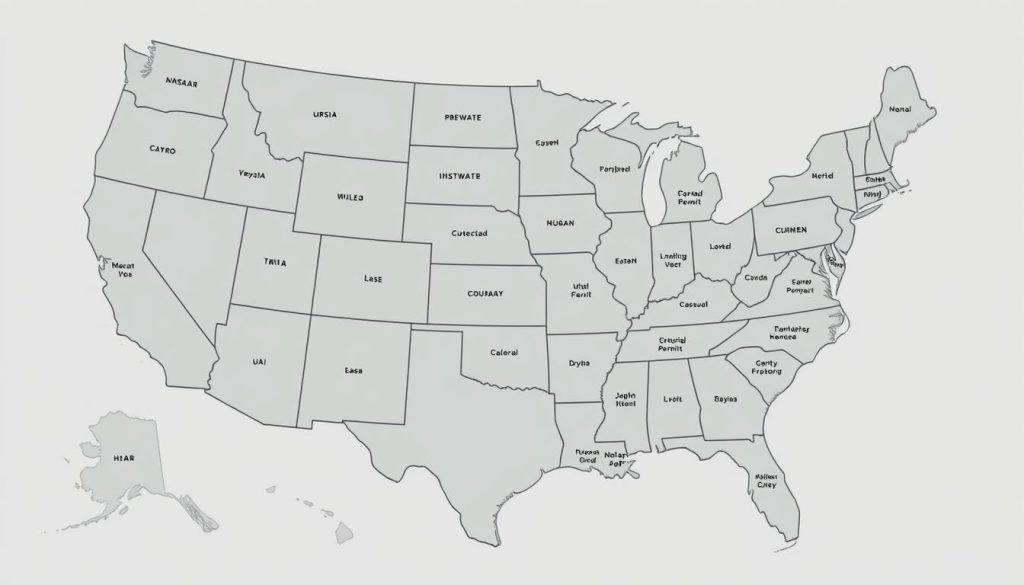
On the other hand, many eastern states are slower to make rules for greywater. Some states treat greywater like sewage, with strict rules. Others have no specific rules, making it hard for homeowners to save water.
| State | Regulatory Approach | Permit Requirements | Allowed Uses |
|---|---|---|---|
| Arizona | Progressive | Tiered system; no permit for systems under 400 GPD | Landscape irrigation, toilet flushing |
| California | Comprehensive | Permit required for complex systems | Subsurface irrigation, laundry-to-landscape |
| New York | Restrictive | Difficult to obtain | Limited to certain irrigation |
| Texas | Moderate | Required for most systems | Irrigation only |
| Florida | Developing | Required with exceptions | Irrigation with restrictions |
Permitting Requirements and Processes
Getting a permit for a water reuse system involves several steps. You usually need to submit plans, have a site check, and sometimes soil tests. You’ll need to provide detailed diagrams, component specs, and site plans showing distances from property lines and water sources.
Fees for permits vary a lot. They can be under $100 in some states or over $300 in others. The number of inspections needed also varies. Some places require inspections at different stages, while others only check the system once before it’s used.
The type of system you plan affects the permits needed. Simple systems like laundry-to-landscape often face fewer rules than whole-house systems that need more plumbing changes.
Working with Local Authorities
Getting sustainable plumbing approved often means working with different agencies. Building departments handle plumbing changes, while health departments look at public health risks. Water districts might have rules about water use and runoff.
When talking to officials, be ready with research and examples. Many local authorities are new to greywater systems, so you might need to teach them about modern practices and safety.
Having allies in regulatory agencies can help a lot. Look for officials who support sustainability. In places with old rules, consider starting a group to push for updates that match current technology and safety standards.
Even if rules seem strict, following them is key. Working within the system and pushing for changes can help make greywater recycling more accessible to everyone in your area.
Common Concerns and Misconceptions About Greywater Recycling
Homeowners often face both real concerns and myths about greywater recycling. It’s important to know the facts about treating wastewater at home. This helps clear up worries about health, upkeep, or how well these systems work.
Most worries are solved by good system design and years of success in different places. Let’s look at the main questions and myths. This will help you decide if greywater recycling is good for your home.
Addressing Health and Safety Concerns
The main health worry is about germs in greywater. Modern systems keep greywater away from people and drinking water. They also make sure greywater and drinking water don’t mix.
For watering plants outside, greywater is kept underground. This acts like a natural filter, killing germs. Also, greywater shouldn’t sit for more than 24 hours to stop germs and bad smells.
Keeping the system clean and using the right soaps lowers health risks. When done right, greywater systems are safe and good for the planet.
Debunking Common Myths
Some think greywater always smells bad. But, fresh greywater smells little, and good systems stop bad smells. Another myth is that greywater hurts plants. But, most plants do well with greywater if the right soaps are used.
Many think greywater systems need complex filters and treatments. But, for watering plants, simple filters and the soil itself are enough. This makes greywater easy to use.
It’s also believed that greywater systems are hard to keep up. But, simple systems like laundry-to-landscape or shower diversion are easy to maintain. Homeowners can handle these with basic cleaning and checks.
Real vs. Perceived Risks
The real risks of greywater recycling are low with the right system and care. You just need to pick the right soaps, check the system often, and know the local rules. These steps are doable for most families.
Many fears come from mixing up greywater with blackwater (toilet waste). Greywater from showers, laundry, and sinks is much cleaner. It’s safe to reuse with simple precautions.
Some worry that greywater systems lower property value. But, they actually attract eco-friendly buyers. As saving water becomes more important, these systems are seen as valuable features.
Eco-Friendly Products That Complement Greywater Systems
Starting a greywater recycling system means choosing the right eco-friendly products. The chemicals in your soaps and cleaners affect your greywater’s quality. By picking the right products, you make sure your greywater is good for plants and helps the environment.
The products you use at home are key to treating wastewater well. Instead of filtering out bad chemicals later, stop them from getting in your system. This makes your water management more sustainable.
Biodegradable Soaps and Detergents
Biodegradable soaps and detergents break down in soil without harming plants. Look for “biodegradable,” “plant-based,” or “greywater-friendly” labels. Seventh Generation, ECOS, and Dr. Bronner’s make laundry detergents safe for greywater.
For DIY fans, making laundry soap with castile soap and baking soda is a good choice. These ingredients clean well and are gentle on your system and the environment. Avoid borax, as it can harm plants over time.
Plant-Safe Cleaning Products
Choose cleaning products with plant-based surfactants and natural enzymes. These clean well and break down in soil. Look for Green Seal certified brands like Method and Mrs. Meyer’s for various cleaning needs.
It’s also important to know what to avoid. Stay away from products with boron, sodium, bleach, and antibacterial agents. These can harm plants and soil. Vinegar and citric acid cleaners are great for bathrooms without harmful chemicals.
Water-Efficient Appliances
Using water-efficient appliances with your greywater system is a great combo. High-efficiency washing machines with adjustable water levels save water and fit different loads. Look for ENERGY STAR certified models.
Choose appliances designed for greywater systems. Some washing machines have built-in greywater diversion or easy drain hoses. Low-flow showerheads and faucet aerators also help save water without losing performance.
| Product Category | Key Ingredients to Look For | Ingredients to Avoid | Recommended Brands | Environmental Impact |
|---|---|---|---|---|
| Laundry Detergents | Plant-based surfactants, coconut-based cleaners, essential oils | Phosphates, borax, sodium compounds, brighteners | Seventh Generation, ECOS, Dr. Bronner’s | Low soil impact, biodegradable, safe for plants |
| Bathroom Cleaners | Citric acid, vinegar, plant enzymes | Bleach, antibacterial agents, ammonia | Method, Biokleen, Mrs. Meyer’s | Non-toxic to soil microbes, plant-safe |
| Dish Soaps | Vegetable-based surfactants, glycerin | Triclosan, petroleum derivatives | Ecover, Attitude, Meliora | Breaks down quickly, minimal residue |
| Personal Care | Saponified oils, aloe, vegetable glycerin | Parabens, sulfates, microbeads | Alaffia, Everyone, Plaine Products | Biodegradable, non-toxic to aquatic life |
Choosing eco-friendly products for your home is a smart way to conserve water. These choices improve your greywater quality and help the environment. Remember, treating wastewater starts with what you put down your drains, not just how you manage the water later.
Real-Life Success Stories: Homes Transformed by Greywater Recycling
Greywater recycling is changing how Americans use water, from city apartments to rural homes. It’s not just a theory; it’s a real solution that helps homeowners. Let’s look at how different families have made these systems work in their homes and the great results they’ve seen.
Urban Applications and Space-Saving Solutions
In cities, finding ways to save water is tough. But, some urban residents are finding smart solutions. In Seattle, Maria Chen set up a system to use bathroom sink water to flush her toilet. This saves about 30 gallons a day in her 800-square-foot apartment.
In Chicago, James Wilson used his small outdoor space for a vertical garden. He feeds it with greywater from his shower and laundry. His system is tiny, but it supports lush plants on his balcony.
Rural and Suburban Implementation Examples
Those with bigger homes have set up bigger greywater systems. The Martinez family in suburban Phoenix turned their lawn into a desert garden. They use greywater from their showers, laundry, and sinks to water it.
In rural Vermont, the Hendersons built a wetland to clean their greywater. It irrigates their big vegetable garden. This way, they can grow food even when it’s dry.
A community in Colorado worked together on a greywater system. It collects water from 12 homes, filters it, and waters community green spaces. This shows how working together can help everyone.
Before and After: Measurable Results
Greywater recycling really cuts down on water use. It can save 30-50% of indoor water, which also lowers water bills. In California, the Wilson family’s water bill went from $120 to $65 a month after installing a system.
These homes also save the environment. A study found that 50 homes saved over 2 million gallons of water a year. This is because they use greywater instead of clean drinking water for non-drinking purposes.
The Johnsons in Arizona saw their garden get much better. They took pictures every month to show how their plants grew with greywater. Their garden looked great, even when their neighbors’ yards were dry and brown.
Join the Water Conservation Movement: Your Next Steps
Starting your water conservation journey is easy. Begin by collecting shower warm-up water in buckets. This simple step can save gallons every day. It’s a great start to more advanced greywater practices.
Take a weekend to check your home’s greywater potential. Look at water sources like bathroom sinks and washing machines. Start with saving 10 gallons daily and aim to increase as you grow.
Plan your timeline based on your budget and comfort. Many start with a laundry-to-landscape system. Local stores now sell DIY greywater kits for easy installation.
Connect with others who care about water conservation. Look for workshops, online forums, and local groups. Experts in your community can help make your home more eco-friendly.
Every gallon saved helps the environment. Share your success with neighbors and friends. Your efforts can inspire others and secure water for future generations.

